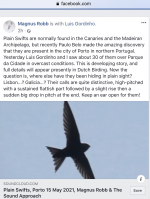John Cantelo
Well-known member
A tweet by Magnus Robb (see below) reveals that Plain Swift (30!) have been reported from Porto by Paulo Belo, This is an extraordinary range extension and must open the possibility that they may be found elsewhere in Portugal and quite possibly Iberia and beyond. The account describes the call as "quite distinctive" which runs counter to what relevant guide suggest.





